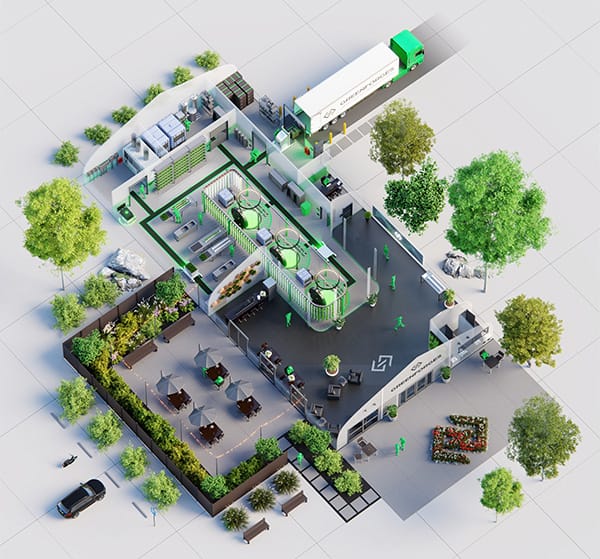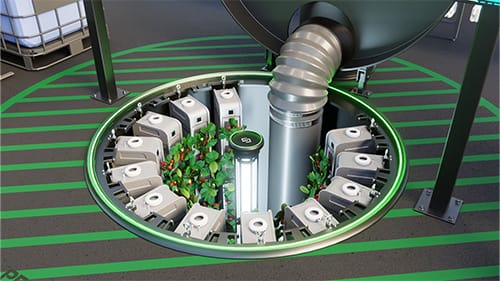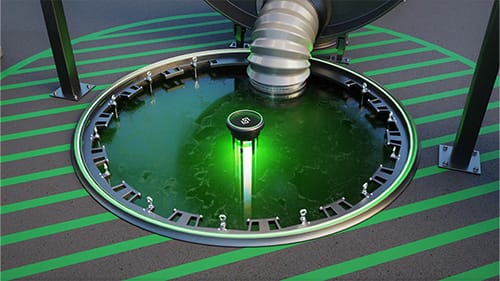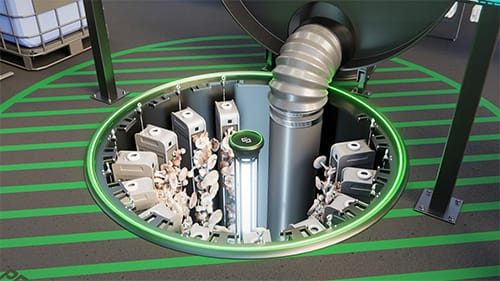GreenForges designs and develops sustainable farming technology to move agricultural production underground. Their purpose is to expand the world’s agricultural output, minimize the human footprint and create new economic opportunities.

Rendering of a proposed Greenforges urban farm
A hunger for innovation
Amidst growing concern about the stability and security of the world’s food supply and the environmental impacts of farming, GreenForges started digging for solutions.
What the fledgling company came up with was an innovative way to overcome the challenges of growing food – from fertilizers and pesticides to irrigation, weather, and arable land,
What’s next for agriculture? According to GreenForges, it is vertical underground farms.
A growing challenge
GreenForges proposes to deliver “100 years of stable, predictable food production in a 60-inch hole.” They have designed vertical underground shafts that resemble wells or missile silos.
These “forges” house hydroponic growing systems. LED lights provide the appropriate durations and wavelengths of light needed for plants to grow, and an HVAC system maintains the temperature and humidity levels of the environment.
Leafy greens and herbs are the first crops of choice. Their narrow degree of variability and short harvest cycle have allowed the team to iterate faster and more quickly refine their inputs and optimize their processes.

The plant forge
Design challenges
It might sound straightforward to simply move a hydroponic setup below ground, but in fact, creating such a system in an underground environment is incredibly complex. To ensure the right environmental conditions for growing crops, the structural, mechanical, electrical, and digital engineering systems must work seamlessly – and correctly – together.
As GreenForges set out to produce the optimal controlled environment, they found very little information on how plants acclimatize to underground environments. The team had to start from scratch.
“But the more you dig in, the more you realize there’s just way more to it. It really is so multidimensional, as I mentioned, on the mechanical, the structural, the lighting, and particularly the horticultural side.” – Jamil Madanat
GreenForges faced design challenges across several areas:
- The grow modules had to be able to accommodate crops of different sizes and deliver adequate nutrients and water efficiently while being easy to use and operate.
- The extraction mechanism should be safe, easy, and reliable to use.
- The climatization loads need to be balanced to create the ideal environment for the plants throughout the growing cycle.
Re-creating the ideal climate

Balancing the climatization loads to create the optimal growing conditions has been an incredibly complex phase.
The team identified four climatization parameters that would need to be controlled and optimized to deliver the right growing conditions:
- Temperature
- Relative humidity
- Air velocity
- Volumetric airflow
But first, they would have to calculate the forge’s climatization loads:
- Cooling load (heat sources / heat sinks)
- Dehumidification load (humidification sources / passive dehumidification)
- Duct design and sizing
The team soon realized that the internal environment of an operational forge is in constant flux, affected by multiple internal and external factors – increasing the complexity of the task by orders of magnitude.
For example, as the plants grow, their needs change – and so does the effect they have on their environment. Early in the growth cycle, plants generate little to no humidity, but as they grow, evapotranspiration increases exponentially, influencing the ambient humidity level. Added to this, different crops breathe differently and have different needs for humidity, temperature and light.
Another complexity is the temperature gradient of the surrounding soil – the external environment. At a certain depth (beyond 7 meters), the temperature remains relatively constant. However, the forge itself extends all up to the surface, traversing soil of different temperatures and types, creating heat transfer. And then, there’s the lighting needed for the plants to grow. The forge uses LEDs, but these give off some heat as well.
The heat transfer factor is significant, and the HVAC system needs to be able to manage it and efficiently bring the hot air back up.
Optimizing the climatization parameters would not be a simple task.
“Overall it was a very positive experience working with the Maya team. They were inquisitive, accommodating, and prompt in communication. I’m looking forward to us working together during the second simulation phase.” – Jamil Madanat
Simulation: the root of the solution
GreenForges turned to computational fluid dynamics (CFD) and Maya HTT to better understand the forge’s climatization loads and explore how to balance them.
They used Simcenter 3D, a computer-aided engineering (CAE) software from Siemens Digital Industries Software, to create a virtual model of a vertical farm and perform heat transfer and CFD simulations.
With Simcenter 3D, GreenForges was able to:
- Study the thermal transfer and flow.
- Simulate heat transfer at different depths, with different soil types and with different levels of humidity.
- Predict the cooling and dehumidification loads within the vertical farm.
- Account for temperature gradients, humidity distribution, and the prediction of specific areas where condensation will occur.
- Calculate the climatization loads.
- Size the ducts, HVAC system, piping and pumps needed to remove condensation from the bottom.
Simulation Phase 1
In the first simulation phase, GreenForges hoped simulation would help answer two overarching questions about the ducting design:
- What are the heat and dehumidification loads needed to size the HVAC units?
- Would the current design be sufficient to handle the loads?
Condensing answers and savings
Simulating the condensation was integral to understanding:
- How to size the pump located at the bottom of the forge that must continuously pump the condensation water to recycle the water and avoid flooding
- What final power (wattage) the HVAC unit would require to provide adequate climatization to the forge
Results from the simulation suggested that the forge design could achieve a significant energy savings compared to on-surface farms in three ways:
- Via heat loss to the soil
- Via the collection and recycling of humidity condensate
- Via casing-surface condensation due to steel-soil temperature differential

An algae forge design
Correcting critical load assumptions
Simulation yielded a critical finding about volumetric airflow. The presumed amount would be insufficient to adequately extract humidity. (And an overly humid environment would lead to a failed grow cycle.)
Based on the simulation results, the team pivoted to make two major design changes:
- Expand the forge diameter from 40″ to 60″ to accommodate a larger duct size
- Reduce the forge depth from 100′ to 50′ to reduce the load without sacrificing duct size and plant growth
The simulation also showed that improper air mixing would lead to wider temperature differentials in the forge, which would yield inconsistent crop results.
This too was a critical finding that led to a significant design change: The inlet and outlet ducts will be designed with perforations to ensure adequate air mixing throughout the length of the forge. In addition turbulence fans will be added to boost air mixing.
Simulation Phase 2
In the next phase of simulation, the team will create a new design and simulate the heat distribution through the forge to ensure that the duct size and volumetric airflow are sufficient to maintain a relatively homogenous distribution of temperature and relative humidity throughout the forge.
From there, the team expects to establish the optimal operating conditions across the plant growing cycle.
Heat transfer and CFD – Partners in expertise
Maya HTT’s expertise was instrumental in obtaining and interpreting the CFD simulation results. The team helped to simulate the heat transfer at different soil levels, with different soil types, and different humidity levels.
“Maya HTT helped us better understand how to climatize the environment underground.” – Jamil Madanat
Testing and integrating subsystems
Testing a physical prototype of the whole underground farm system would be impractical for a large number of parameter combinations. Drilling multiple holes and equipping them with all the internal components would be prohibitively expensive. It’s not a feasible way to test the system.
First, GreenForges took a subsystem approach to testing, running experiments in parallel at several labs. They turned to simulation to validate their assumptions about two key thermal questions:
- How much heat does this soil absorb during the day cycle?
- How much heat does it retain during the night cycle?
The results allowed the team to establish the groundwork of truth needed to confidently build up the foundations of their design.

A fungi forge
“It wasn’t easy, but it was the best approach to get a more comprehensive design.” – Jamil Madanat
“GreenForges couldn’t go out and drill 50 holes. So we helped them drill 50 holes in a virtual environment with software and look at the mechanical, thermal, and flow performance of the design. Then when they’re ready to drill some holes, they’ll drill only a couple because there’ll be a much higher probability of the design being successful, thanks to the virtual prototyping.” – Carl Poplawsky
Benefits
Produce-ing results
Simulation helped GreenForges iterate a preliminary design. CFD simulation and virtual prototyping have helped speed up development and reduce the expense and time commitment of creating multiple physical prototypes. Virtual prototyping is an efficient replacement for the large number of physical tests that would be required.
Although the final design will still need to be physically tested, the virtual prototyping ensures that when it is tested, it will have a high probability of success.
“That kind of dynamic or behavior of temperature distribution underground at different soil conditions is not something that you just can pull off at the back of the napkin. That’s definitely where the Maya HTT team came in very, very handy and useful in helping us understand it.” – Jamil Madanat
Testing the design and growing conditions with a small-scale on-surface system was successful. Having grown a successful first harvest, eaten a tasty first meal, and signed a first client, GreenForges is on track to kick off its first full-scale facilities in late 2023.
This is a significant achievement over the span of just over three years. GreenForges has gone from a concept on a napkin to successful growing a head of lettuce with the help of CFD simulation and Maya HTT. GreenForges plans to keep on innovating to serve up more great results for sustainable agriculture and a better world.

Figure 6. CFD Simulation results of air temperature distribution in a full scale GreenForge during the initial growth stage without air distribution optimization (Credit: Maya HTT)
